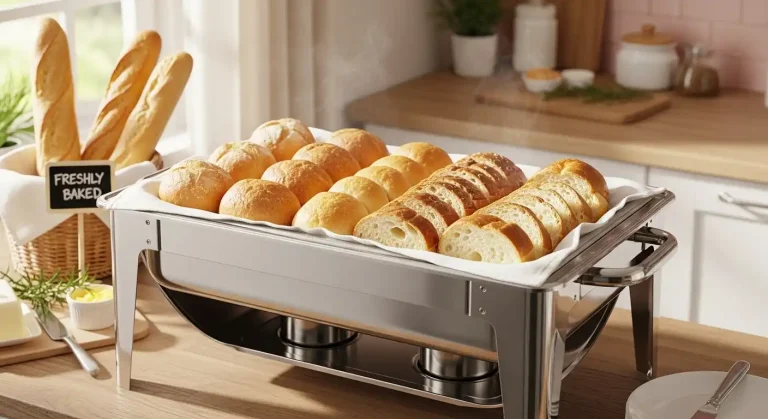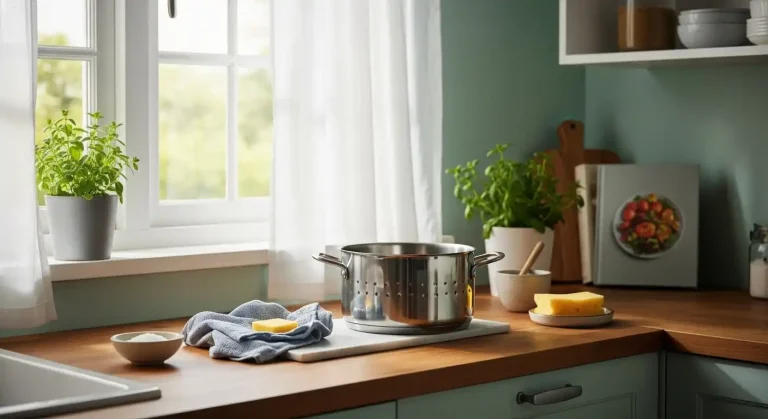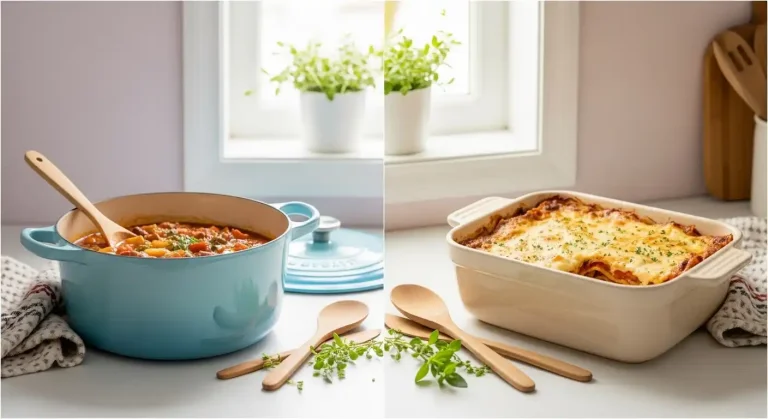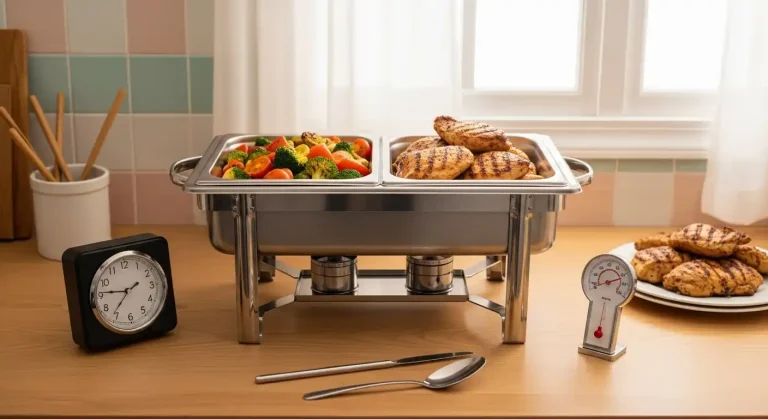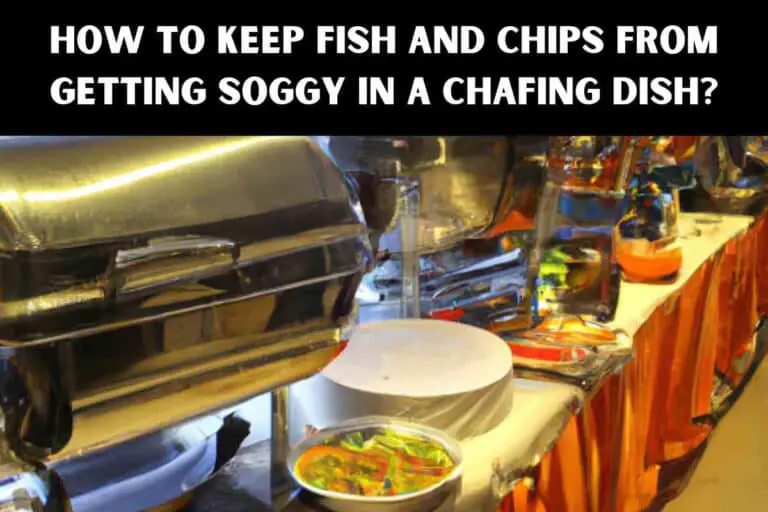Can You Deep Fry In Enameled Cast Iron?
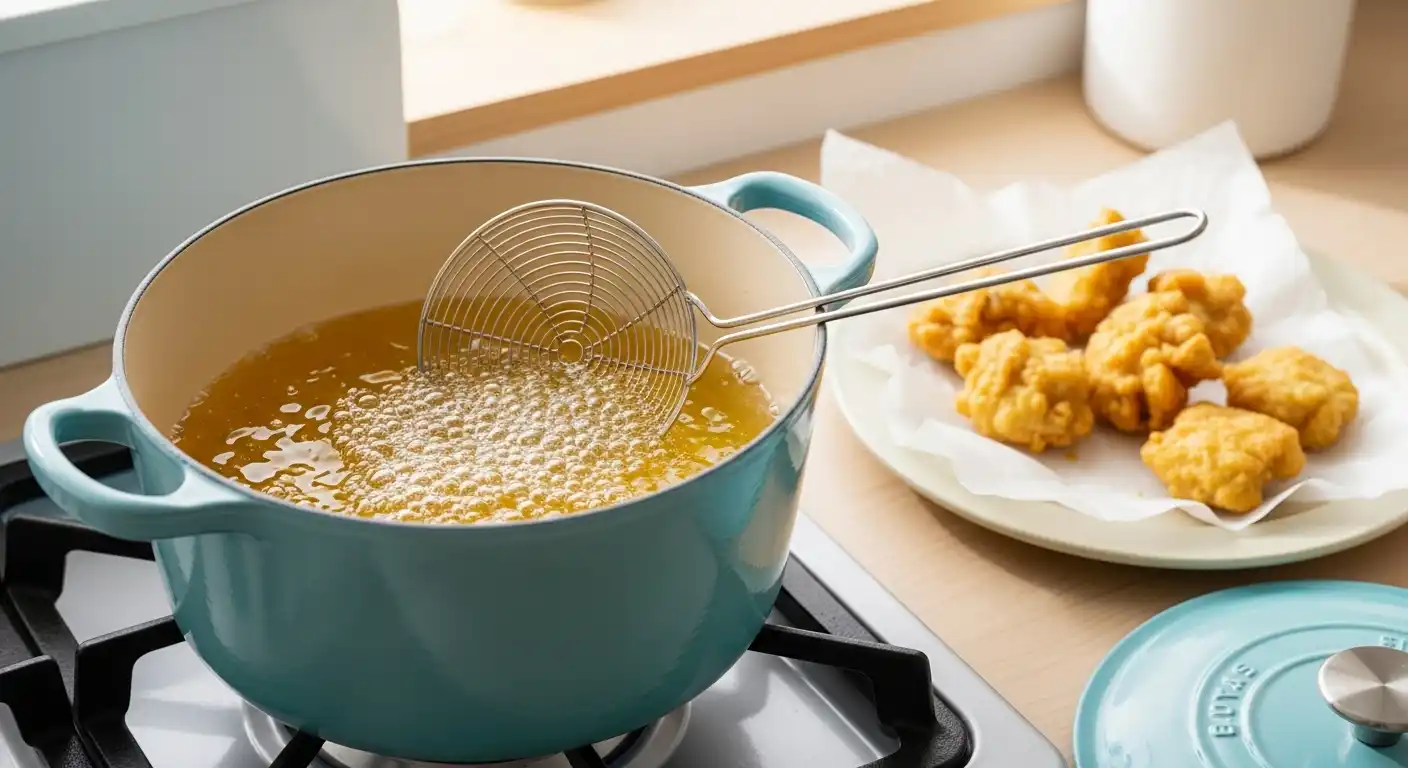
Deep frying transforms ingredients into crispy, golden delights. For home cooks, finding the right cookware for high temperatures and significant oil volume is crucial.
Traditional cast iron offers excellent heat retention but requires meticulous seasoning and can react with acidic foods.
Enameled cast iron combines cast iron’s robust heat properties with a smooth, non-reactive enamel coating.
Can you deep fry in enameled cast iron? This guide explores its suitability, advantages, drawbacks, and best practices for a safe and delicious deep-frying experience.
🎄 Christmas & Year-End Amazon Deals !
Don’t miss out on the best discounts and top-rated products available right now!
*As an Amazon Associate, I earn from qualifying purchases.
Understanding Enameled Cast Iron: More Than Just Pretty Cookware
Enameled cast iron cookware is traditional cast iron coated with a vitreous enamel layer, fused at high temperatures for a durable, non-porous, and non-reactive surface.
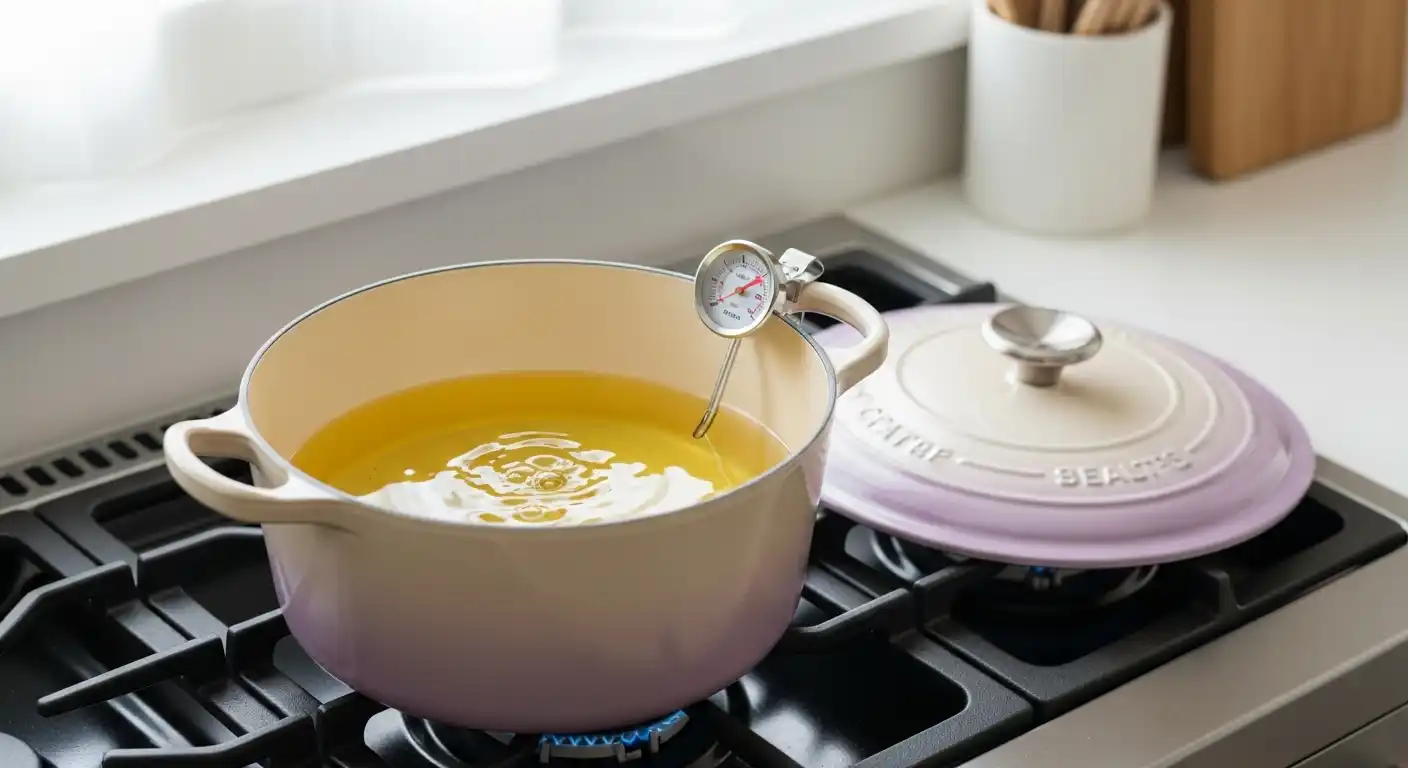
Unlike bare cast iron, enameled cast iron requires no seasoning, simplifying maintenance and cleaning.
It also prevents iron leaching, which can impart a metallic taste.
Beyond aesthetics, its excellent heat distribution and retention are crucial for various cooking methods, including deep frying.
Can You Deep Fry In Enamelled Cast Iron? The Definitive Answer
Yes, absolutely! Enameled cast iron is an excellent choice for deep frying, ideal for home cooks due to its ability to maintain consistent high temperatures.
The thick walls and heavy bottom of enameled cast iron cookware, especially Dutch ovens, ensure even heat distribution, preventing hot spots and scorched oil.
Crucially, once heated, it retains heat remarkably well, minimizing temperature fluctuations when food is added.
This stability is vital for achieving a crispy exterior without greasy results.
Unlike traditional cast iron, the enamel coating prevents oil from reacting with the metal, preserving the oil’s flavor and preventing metallic off-notes in your fried foods.
The Advantages of Deep Frying in Enameled Cast Iron
Choosing enameled cast iron for your deep-frying endeavors comes with a host of benefits that elevate the entire cooking process.
These advantages stem from the unique combination of cast iron’s thermal properties and the protective, versatile enamel coating.
Superior Heat Retention and Distribution
Deep frying demands consistent oil temperature, typically 325°F-375°F.
When cold food is added, oil temperature drops; a pan with poor heat retention struggles to recover, leading to greasy results.
Enameled cast iron acts as a thermal battery, absorbing and releasing heat slowly and evenly.
🎄 Christmas & Year-End Amazon Deals !
Don’t miss out on the best discounts and top-rated products available right now!
*As an Amazon Associate, I earn from qualifying purchases.
This maintains stable oil temperatures, even with multiple batches, ensuring perfectly fried outcomes.
Non-Reactive Surface for Flavor Integrity
Unlike bare cast iron, enameled cast iron is completely non-reactive.
This prevents metallic flavors from transferring to your food, especially with acidic marinades.
This non-reactive property also allows safe storage of cooled oil in the pot, though separate container storage is recommended.
The enamel won’t corrode from oil contact, simplifying cleanup and extending cookware life.
Easy Cleanup and Maintenance
One of the most appealing aspects of enameled cast iron is its ease of cleaning.
Its smooth, glass-like surface prevents food from sticking and eliminates the need for rigorous seasoning.
After deep frying, once the oil is safely removed and the pot cooled, a simple wash with warm, soapy water and a non-abrasive sponge is usually sufficient.
This low-maintenance nature makes post-frying cleanup much less daunting compared to traditional cast iron, encouraging more frequent use.
Versatility Beyond Deep Frying
Beyond deep frying, enameled cast iron is incredibly versatile.
A Dutch oven can transition seamlessly from frying to braising, stewing, or baking, making it an indispensable kitchen tool.
This multi-functionality makes investing in quality enameled cast iron a wise decision.
🎄 Christmas & Year-End Amazon Deals !
Don’t miss out on the best discounts and top-rated products available right now!
*As an Amazon Associate, I earn from qualifying purchases.
For more on cast iron versatility, explore topics like Can You Use a Cast Iron Skillet on an Induction Cooktop? or Can Your Cast Iron Skillet Go in the Oven?.
Potential Drawbacks and Considerations
While enameled cast iron offers numerous benefits for deep frying, it’s important to be aware of some potential drawbacks and considerations before you dive in.
Understanding these aspects will help you make an informed decision and ensure the longevity of your cookware.
Weight and Handling
Cast iron is inherently heavy, and adding oil and food makes an enameled cast iron Dutch oven even heavier.
This can be a significant consideration when moving the hot pot or pouring out used oil.
Always use caution and two hands when handling a hot, heavy pot. Consider using a ladle or funnel to safely transfer cooled oil.
Thermal Shock: A Crucial Warning
Enameled cast iron is durable, but its enamel coating is susceptible to thermal shock—sudden temperature changes that can cause cracking or chipping. This is irreversible.
To prevent this, always allow your enameled cast iron to cool gradually before washing.
Similarly, avoid adding frozen foods directly to very hot oil; thaw ingredients first.
This care point differentiates it from more forgiving bare cast iron.
Cost Investment
Quality enameled cast iron cookware represents a significant investment.
While durable and versatile, the initial cost can be higher than other deep-frying vessels.
🎄 Christmas & Year-End Amazon Deals !
Don’t miss out on the best discounts and top-rated products available right now!
*As an Amazon Associate, I earn from qualifying purchases.
However, its multi-purpose utility often makes it a cost-effective choice long-term.
For insights into cast iron costs, see How Much Does a Good Cast Iron Skillet Cost?.
Discoloration Over Time
While non-reactive, prolonged high heat and oil exposure during deep frying can cause discoloration or staining of the interior enamel, especially in lighter colors.
This is mainly aesthetic and doesn’t affect performance.
Regular cleaning helps minimize discoloration.
Stubborn stains can often be restored with baking soda paste or specialized cleaners, though some staining is a natural part of aging.
Best Practices for Deep Frying in Enameled Cast Iron
To ensure a safe, efficient, and delicious deep-frying experience with your enameled cast iron, follow these best practices:
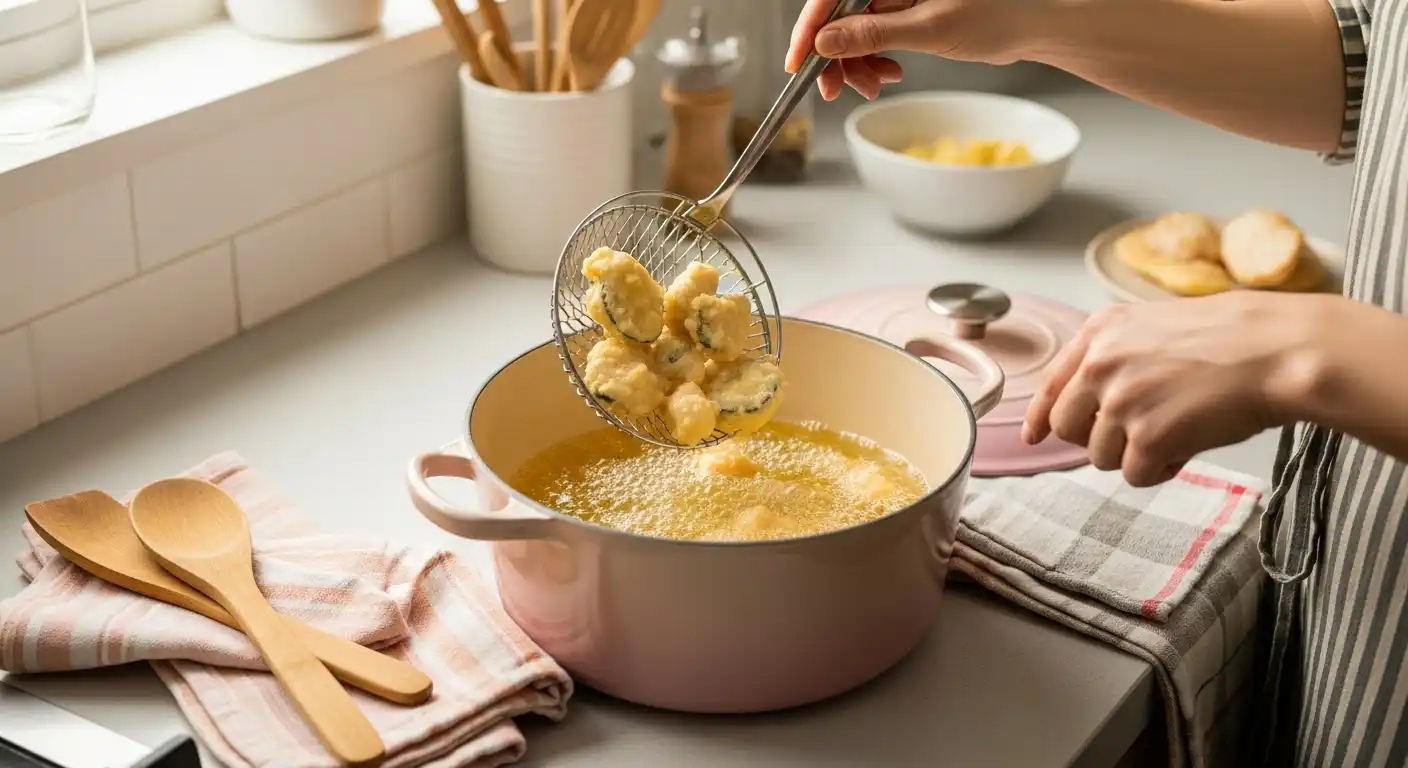
Choosing the Right Size and Shape
For deep frying, a deep pot with high sides, like an enameled cast iron Dutch oven, is essential to prevent oil splatters and accommodate oil volume.
Ensure it’s large enough to submerge food without overflowing.
Avoid shallow skillets for deep frying due to safety risks.
For other cast iron options, consider Wok vs. Cast Iron Skillet or Lodge Cast Iron Wok.
Temperature Control is Key
Accurate oil temperature is paramount for successful deep frying. Too low, and food becomes greasy; too high, and it burns.
🎄 Christmas & Year-End Amazon Deals !
Don’t miss out on the best discounts and top-rated products available right now!
*As an Amazon Associate, I earn from qualifying purchases.
Always use a reliable deep-fry thermometer. Heat oil gradually over medium heat.
Enameled cast iron’s excellent heat retention ensures stable temperatures, requiring only minor adjustments.
Avoid excessively high heat to prevent enamel damage.
Oil Selection and Quantity
Choose an oil with a high smoke point (e.g., vegetable, canola, peanut, grapeseed) to withstand high frying temperatures without breaking down.
The oil quantity should fully submerge food, but never fill the pot more than two-thirds full to prevent overflow.
For tips on reducing smoke when cooking with cast iron, see How to Reduce Smoke When Cooking with Cast Iron.
Safety First: Preventing Splatters and Burns
Deep frying involves hot oil, which can be dangerous if not handled properly.
Always lower food gently into the hot oil using tongs or a spider strainer to avoid splatters.
Do not overcrowd the pot, as this will lower the oil temperature and can lead to uneven cooking and more splattering.
Keep a fire extinguisher rated for grease fires (Class K) readily accessible.
Never use water to extinguish a grease fire.
Ensure good ventilation, and keep children and pets away from the stovetop.
Caring for Your Enameled Cast Iron After Deep Frying
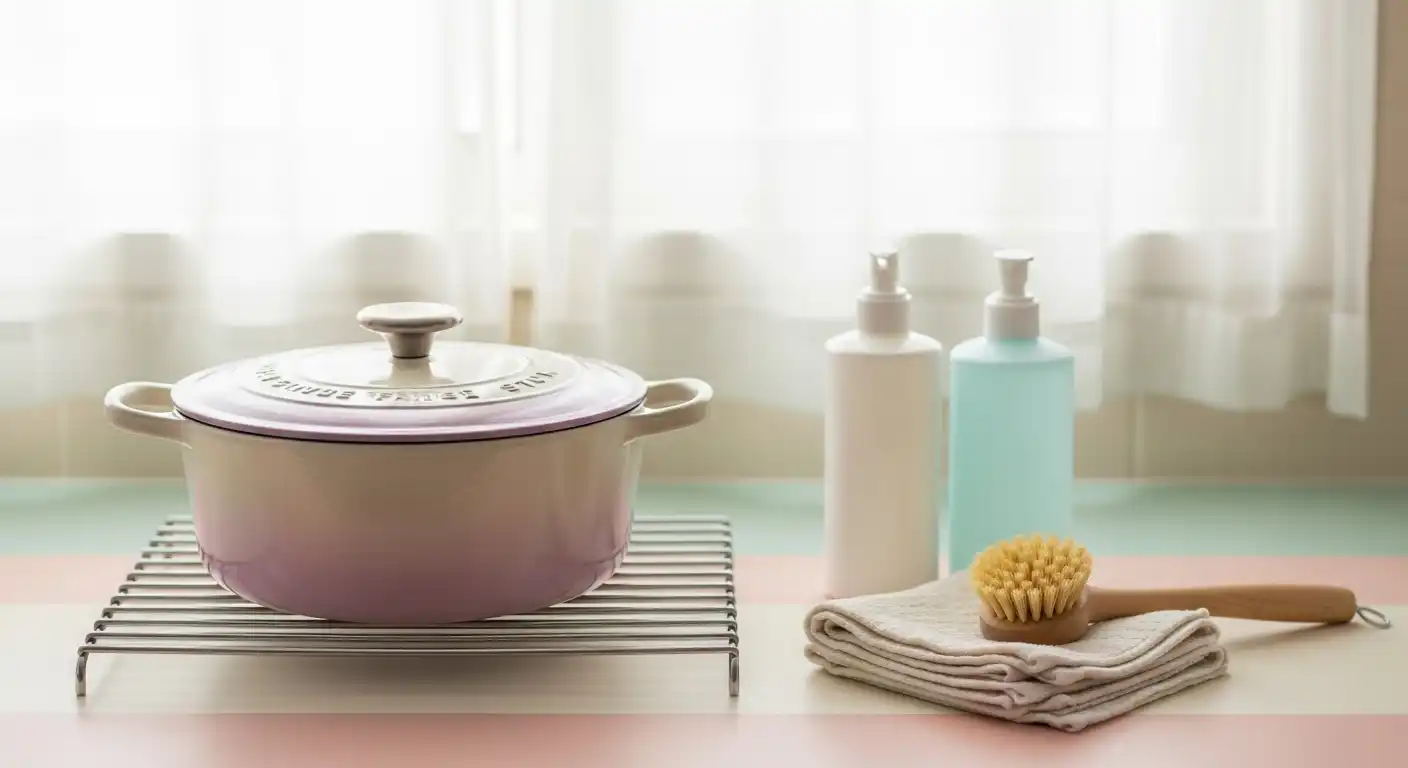
Proper care after deep frying is crucial for maintaining the beauty and performance of your enameled cast iron cookware.
Following these steps will ensure your pot remains in excellent condition for years to come.
🎄 Christmas & Year-End Amazon Deals !
Don’t miss out on the best discounts and top-rated products available right now!
*As an Amazon Associate, I earn from qualifying purchases.
Cooling Down Properly
As mentioned, thermal shock is a significant concern.
After deep frying, turn off the heat and allow the oil to cool completely within the pot.
This can take several hours, so patience is key.
Once cool, carefully strain the oil through a fine-mesh sieve lined with cheesecloth into an airtight container for future use or proper disposal.
Never pour hot oil down the drain.
Gentle Cleaning Techniques
Once the pot is cool and empty, fill it with warm, soapy water and let it soak for 15-20 minutes to loosen stuck-on food.
Use a non-abrasive sponge or soft brush to gently scrub. For stubborn residue, a baking soda paste can be effective.
Avoid harsh abrasive cleaners, steel wool, or metal scouring pads, as these can scratch the enamel.
Hand washing is generally recommended over dishwashing to preserve the finish.
Thoroughly rinse and dry immediately to prevent water spots.
Storage Tips
Store your enameled cast iron in a dry place.
If stacking other cookware, place a soft cloth or pan protector between pieces to prevent scratches.
🎄 Christmas & Year-End Amazon Deals !
Don’t miss out on the best discounts and top-rated products available right now!
*As an Amazon Associate, I earn from qualifying purchases.
Proper storage maintains its pristine condition.
For general cast iron care, see How to Clean a Cast Iron Wok or Seasoning Cast Iron Dutch Oven, though enameled cast iron doesn’t require seasoning in the same way.
Conclusion: Embrace the Fry with Confidence
So, can you deep fry in enameled cast iron?
Absolutely! It’s an exceptional choice, offering superior heat retention, even distribution, and a non-reactive surface for consistent, delicious results.
Its ease of cleaning and versatility further solidify its position.
While considerations like weight, thermal shock, and initial cost exist, the benefits outweigh the drawbacks for most home cooks.
By understanding its properties and adhering to best practices, you can confidently transform your kitchen into a deep-frying haven.
Embrace the joy of deep frying with confidence, knowing your enameled cast iron pot is a reliable partner for culinary perfection.

